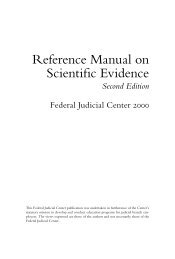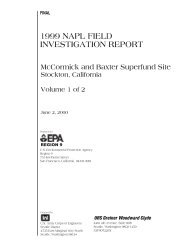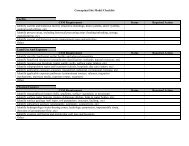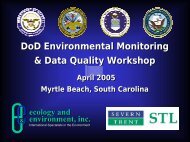Source Zone Delineation Demonstration Report - Triad Resource ...
Source Zone Delineation Demonstration Report - Triad Resource ...
Source Zone Delineation Demonstration Report - Triad Resource ...
Create successful ePaper yourself
Turn your PDF publications into a flip-book with our unique Google optimized e-Paper software.
5.0 RESULTS OF SOIL SAMPLING AND SVE DEMONSTRATIONThe results from the Wireline CPT soil sampling and SVE demonstrations conducted in the suspectedsource zone at OU 12 are described in this section.5.1 OU 12 Soil Data EvaluationDuring the nine working days of Wireline CPT soil sampling, 599 soil samples were collected from 16discrete push locations (see Figure 5-1). The depth profiles generated based on the TCE soilconcentration data are shown in Figures 5-2 and 5-3 for concentrations less than 350 g/kg and greaterthan 1,000 g/kg, respectively. The analytes PCE, DCE, and vinyl chloride were below the projectreporting limits in all soil samples analyzed. A summary of the soil sampling results obtained during theWireline CPT demonstration is shown in Table 5-1.Samples were collected using either distilled water or methanol as an extractant and analyzed accordingto US EPA Method 8265 (see Section 3.3). During the analysis of samples collected from U12-1807,four samples (30 to 33 feet bgs) were observed to contain a light nonaqueous phase liquid (LNAPL) asshown in Figure 5-4. In addition, two samples (27 to 29 feet bgs) from U12-1804 were observed tocontain a LNAPL. With the exception of U12-1817, distilled water was used as the extractant during theWireline CPT demonstration; thus, it is surmised that the measured TCE concentrations in samplescontaining LNAPL from U12-1804 and U12-1807 are biased low due to incomplete extraction associatedwith the preferential partitioning of the TCE into the LNAPL. Methanol was used as the extractant forthe analysis of soil samples collected from U12-1817, located approximately 10 feet southeast of U12-1804 and adjacent to the excavated drum area. Based on the TCE concentrations observed at U12-1817,an LNAPL/water partitioning factor of approximately 10 was estimated. This factor was used to adjustthe TCE soil concentration of two samples (15,400 g/kg at 27 feet bgs and 7,300 g/kg at 29 feet bgs)collected at U12-1804 and one sample (14,400 g/kg at 33 feet bgs) collected at U12-1807.Inference of the magnitude and spatial extent of TCE contamination in the vadose zone at OU 12 wasaccomplished using three-dimensional modeling of TCE concentration measured in soil samples retrievedwith a the Wireline CPT sampler. Iterative, short-delay modeling of the extent of contamination (themodel was expeditiously revised whenever new data were received from the field) provided fieldpersonnel with guidance for selecting new wireline sampling locations. The relationship between TCEcontamination and soil type was investigated with the benefit of three-dimensional modeling of thearchitecture of the main soil types in the vadose zone, based on CPT data acquired during previousinvestigations at OU 12.All three-dimensional subsurface modeling performed in this investigation was performed using thekriging and visualization algorithms available in the EVS-Pro software system (CTECH, 2002). Ordinarykriging (Isaaks and Srivastava, 1989; Gooevaerts; 1997) was used to model TCE contamination, whereasindicator kriging (Isaaks and Srivastava, 1989; Gooevaerts; 1997) was used to model the distribution ofsoil types.March 2003 5-1 OU 12 <strong>Demonstration</strong> <strong>Report</strong>Final










